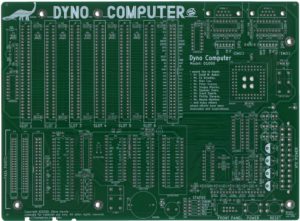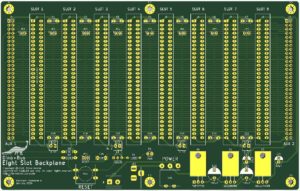Dyno Computer
Dyno Computer
Micro-ATX
Model: D1000
The Dyno Computer Motherboard is the foundation of the project. It provides all of the functionality of a complete computer to run the ROMWBW software environment and allows for expansion via its Dyno•Bus slots. The motherboard features:
- A Zilog Z180 CPU running at 18.432 MHz,
- Two asynchronous serial ports accessible via TTL-levels or RS-232,
- ROMWBW-compatible memory with 512 MB of ROM (Flash) and 512 MB of battery-backed up RAM managed by the Z180 MMU,
- Real-Time Clock with support for CPU reset at power-up and watchdog monitoring,
- Support for 8- and 16-bit IDE storage devices (i.e., Compact Flash, Hard Drive and Disk On ROM),
- Uses ATX power supply with soft controls,
- A system register that controls SPI addressing, a beeper and software-control to reset or shutdown the computer, and
- Six Dyno•Bus expansion slots.
The Dyno•Bus provides access to:
- The 8-bit data bus;
- The 20-bit address bus;
- The Z180 control signals: (RD, WR, MREQ, IORQ, M1, WAIT and RESET;
- The Z180 bus mastering signals: BUSRQ and BUSAK;
- The Z180 DMA signals: DREQ1 and TEND1;
- The Z180 clock signals: PHI and CLK;
- The Z180 interrupt signals: INT0, INT1, INT2 and NMI as well as the interrupt cascading signals IEI and IEO;
- The Z180 CSIO signals: CKS, RXS and TXS as well as the slot selection signal: SEL for SPI emulation; and
- I²C signals: SDA and SCL.
Prototype
Dyno Computer
Eight-Slot
Model: D1005
The Dyno Computer Eight-Slot Backplane simply implements the Dyno•Bus with both 5-volt and 3.3-volt power. It has two Aux connectors that can be used to connect to the Aux connector on the Dyno Computer motherboard or to another Eight-Slot Backplane.
The development of this expansion card was originally inspired by Spencer Owen’s RC2014® computer.


